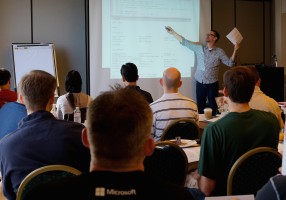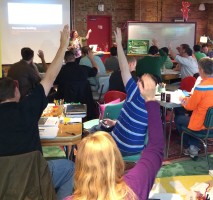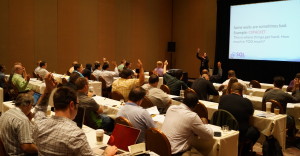
We teach a lot of courses. In addition to our online training, free webcasts and sessions at major conferences, we also teach mult-day events.
It’s incredibly valuable to keep your audience active. Even when you’re working in a lecture format, you should try to help give your audience moments where it’s natural for them to mentally wake up and shake themselves out of a more passive listening mode.
Don’t worry: this doesn’t require changing much as a speaker. You don’t have to make your audience square dance.
There’s two big benefits to building habits to keep your audience active:
Benefit 1: Active listeners learn more
When the role of a student is limited to passive absorption, it’s easy to get bored and sleepy. The student has to constantly refocus themselves, and that takes effort on their part. By giving students built-in opportunities to be mentally active, you effectively give their brain less work to do.
Benefit 2: Active learners are More Fun to teach
Imagine standing in front of two rooms of people: in one of them, people are slumped over with glazed eyes. In the other, they’re alert, leaning forward slightly, following you with their eyes, and taking notes.
If you’re a very beginning speaker, both rooms may terrify you. That’s OK. But if you’ve got a few sessions under your belt, the room of alert people is probably much easier to work with. You get natural feedback about what they understand and it adds meaning to your experience. It helps you do a better job. You’re less tired at the end and more energized.
That’s why it’s worth it. Here’s how to get it done.
Warm up your audience

Don’t stand at the front of the room in silence before you get started. Chat with the people who are already there.
It’s OK if this doesn’t come naturally to you. I am very shy and nervous around strangers and small talk is quite difficult for me. You can overcome it! Write down a list of simple questions to ask the audience and even glance at it from time to time so you don’t have to remember:
- Where are people from?
- What other sessions have people been to? What was good? (If you’re at a conference)
- What made them want to attend the session / is there anything they’re looking forward to learning?
Remember to smile. Drawing a smiley face on a post it note somewhere and sticking it on the desk helps, strangely enough. (People won’t even know it’s yours.) Welcome people in as they come into the room casually and let them know you’re glad they’re there. If you’re making eye contact, you’re already helping your audience.
Identify your audience’s job role
One easy question to build into the beginning of your presentation is to ask your audience to identify their job title or job role by raising their hands. Build a simple slide that says, “What’s your job role?” at the top and lists a bunch of options, including “Other”. Ask people to raise their hands when you say their role name out loud. (I usually tell people it’s OK to vote twice if they do more than one thing.)
This is a nearly foolproof method to get most audiences in the United States to interact with you. The question is designed to have no “wrong” answer. It also gives you insight into the background of your audience and their interests.

It’s possible that in some settings the audience will have a hard time even answering this question. Be ready for that, and understand that it’s not you. This gives you an early tip that you may have an quiet group for cultural or situational reasons, which is very useful for you to know!
Ask questions during your presentation
When you first start speaking, audience participation may be scary. Know that you can get past that: questions and comments from the audience are one of the most fun and rewarding things you can work with as a presenter. They help you work in real-world advice and information and make your presentation relevant.
See this as something to build up to gradually over time. Some easier questions to start with:
- How many of you have worked with this feature?
- How many folks have heard of this?
- I’m about to show a big gotcha where I’m going to do ___. Do any of you think you may know what’s coming?
- Who thinks they might try this out?
For all of these questions, you need to be comfortable with the fact that nobody may raise their hand. That’s OK! You can say something like, “Great, it sounds like this is going to be new info for most of you.” Take that as useful information. If nobody says they might try it out, ask why in a friendly way.
Here’s a few pitfalls to avoid:
- If you’ve got a super quiet audience, don’t feel that you have to force the questions or make them interact with you. It’s OK. Go with what feels more natural to you.
- Avoid the question, “Does this make sense?” I’ve had to train myself out of this one. It’s heard as a rheutorical question by many people and may just fall flat.
- Also avoid, “Is anyone confused? / Does anyone not follow me?” Unless you’ve got a super-comfortable, confident, close knit group, most confused people will be shy to raise their hands.
I try to be very open about areas that have been very confusing to me in the past, or which may have stumped me for a while. Don’t force yourself to do this, but if you can get comfortable sharing with your audience what has been hard for you, this may help them get over the fear of “being the one to ask the dumb question”.
Give people an activity
I am a huge fan of challenges, quizzes, and interactive activities in our training classes. I’m always trying to think of new ways that I can engage learners to actively think through problems, because I believe that most people learn better when they get to try to solve a problem.

If you’ve got some presenting experience, you can include quizzes and design activities into your sessions. This does involve some risk taking, because you need to have a way to get people comfortable working together. I like to keep group activities short and give people a clear mission, then meet up again right away as a group to dive back into the class learning, but there’s many ways to do this.
Take breaks. No really, take breaks.
As a presenter, you need breaks. So do your attendees. Getting up and moving around on a regular basis helps people focus. Don’t feel like people are better off if you blast them with learning non-stop: they aren’t!
If you’re presenting with a laptop, you can make it easier for your attendees to relax and laugh during the break. We like to put DBA reactions up on the screen in auto refresh mode during breaks.
Alternate Speakers (if you Can)
We often have multiple speakers for our longer training sessions. This is helpful to us as speakers, but it also helps the audience. Changing up between different people with different presentation styles, manners of speaking, and movement helps people learn actively if you can do it.
Humor is an advanced feature
One of the best ways to keep your audience active is to make them laugh. Laughing wakes people up, gets some fresh air to their brain, and gives the audience a sense of togetherness.
But, uh, this ain’t easy. I’ve had to accept that I’m the funniest when I don’t mean to be. If I want to get good laughs out of the audience, I just need to use some of the methods above to help the audience learn actively. If that’s happening and I’m comfortable being my geeky self, I’ll get some great laughs out of them, and we’re all happy.
You can do this!
Whatever stage of presenting you’re at, you can improve your skills at helping your audience learn actively. If you’re just starting out, it’s ok: first just get comfortable being on stage, then start adding these in gradually.
And if you’re sitting in the audience, wondering what it’s like to be on stage, why not take a chance and try it out?


3 Comments. Leave new
Great post, Kendra!
I tried asking some questions during my last presentation and I loved the outcome. They were a couple simple (yes/no) “have you heard of this?” type questions, so everyone could participate.
First off, it made me relax a bit just knowing that the people in the room were paying attention and interested in what I was saying.
What was even cooler was that those survey questions tied back perfectly to some national statistics that I used later in my presentation.
It doesn’t always work out like that, but it was nice that it did.
This is a topic that’s seldom discussed; great stuff, Kendra. Three of my favorite things are 1) sharing real-life successes; 2) providing step-by-step practical getting started guidance; & 3) providing short, well-documented, consumable demos. Like you, I’ve found that the best humor is spontaneous. Planned efforts can bomb; whereas two of my most engaging humorous moments were completely serendipitous (Brent remembers one of them).
Heh heh heh, indeed I do.